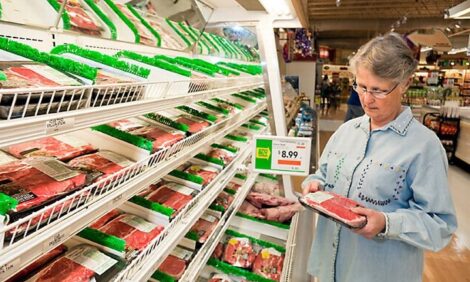



CME: Federally-Inspected Slaughter up 4.6 Per Cent
US - More on last Friday’s discussion of hog marketings and the plummet in cash hogs and lean hogs futures. Last week’s federally-inspected (FI) hog slaughter came in at 2.265 million head, write Steve Meyer and Len Steiner, in the Livestock Report of 27 August.That is the highest level of the
year, up 4.6% from last week and a whopping 6.7% higher than one
year ago. The average weight for hogs harvested Monday-Thursday
(Friday data will not be available until later this morning) was 201.2
pounds, up 0.3 pounds from last week and 1.3 pounds from one year
ago. Estimated pork production for last week is 454.3 million pounds,
7.2% large than one year ago.
It is not hard to see the reason for lower hog prices – LOTS
MORE PIGS AND LOTS MORE PORK. While there are certainly
some valid reasons (heat, rising hog prices — Friday’s DLR addresses
them) to conclude that some hogs may have been backed up a bit, it is
doubtful that slower performance is the complete driver of a surge of
this magnitude. Only time will tell whether the Hogs and Pigs report
inventory estimates were correct but we are hearing MANY reports of
producers making unusually bold efforts to reduce market weights. At
these feed price levels, the marginal cost of the last few “normal“
pounds of gain may indeed be higher than the average hog price of
the past week. In addition, there are growing concerns about being
able to source feed next spring and summer so a pound saved now is
a pound that can be accessed later. Finally, producers know all too
well than once the calendar changes to September hog numbers are
typically large enough to push the capacity of U.S. slaughter plants
putting pricing leverage in the hands of packers and limiting the number of pigs that can be “hurried“ to market. If weights are to be reduced, they must be reduced in August and the past two weeks suggest that the effort is on.
So why have reported weights not decreased? Mother nature. Temperatures cooled sharply the second week of August. Pigs
that had not eaten or grown well all summer breathed a sigh of comfort
and walked to the feeders. The extra intake and growth has, we think,
offset the reductions that we would otherwise have seen. Average
barrow and gilt weights have increased slowly over the past four
weeks — a period that usually marks the lowest weights of the year.
If all of this discussion of lower weights, pulling hogs forward,
etc. is true, we should see lower-than-expected hog numbers around
October 1. Further, they should be lighter than normal. They will almost certainly not be lighter than those being sold now but this past
couple of weeks plus growing concerns about the quality of this corn
crop both suggest that the seasonal increase could be smaller than its
normal 6 pounds of carcass weight.
And what about sow slaughter? While actual sow slaughter data run two weeks in arrears, the purchase numbers in USDA’s
LM-HG230 report indicate that slaughter for the past two weeks has
been about “normal“ and significantly lower than at the end of July.
Sharply lower sow prices will do that and producers have hardly had
enough time to respond to last week’s $4-$6/cwt. increase in sow bids.
The return of school days will improve demand for breakfast sausage,
adding value to these sows and driving bids higher. Producers will try
to maintain herds but many may not have the financial ability to do so.









